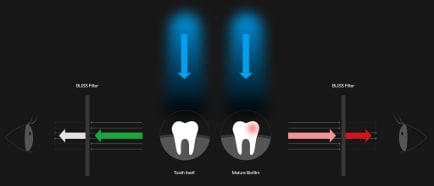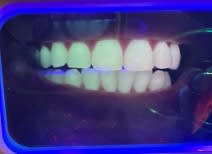As a dental hygienist, a key factor in my love for dentistry from day one was technology. Testing it, implementing it, and, when it works, spreading the word about how it can transform clinical practice. That passion recently took me across the globe to South Korea, where I was invited by AIOBIO (The Artificial Intelligence of Biofilm) to receive specialized training on their BLISS™ (Biofluorescence-Led Intelligent Screening System) technology. The experience gave me not only hands-on patient applications, but also an inside look at the science driving this innovative diagnostic tool.
"Should technology answer all of our questions or help us ask better ones?" I kept asking myself this question throughout the 3-day Global BLISS™ Insights 2025 training, and I am fully convinced that this technology will not only help us to ask better questions, but through its biofilm detection capabilities and artificial intelligence (AI) integration, it can help bridge gaps in the oral-systemic link.
Global BLISS™ Insights 2025 Training
The training program was designed to give a complete immersion into BLISS™ technology, from live patient use to the theoretical underpinnings of its development. It included:
-
Hands-on training with BLISS™ devices in a clinical setting
-
In-depth classroom lectures from the professors and doctors who developed and currently research the technology
-
Cultural exchanges that reminded me technology is global, but relationships make it meaningful
The result? A rare blend of education, innovation, and connection that left me both empowered and motivated (and maybe a little full from all the amazing Korean barbecue).
How it works, and why it matters clinically
When high energy blue light is projected onto the oral cavity the surface of the tooth absorbs some of the energy and remaining energy is emitted as green fluorescence, known as biofluorescence. However, the beauty of BLISS is that its proprietary optical filters convert the green fluorescence into an ivory color. Patients see their teeth as teeth, not a green field. And that’s the feedback I have received from patients I have used the device on. The full suite of products are FDA Class I or FDA 510(K) Class II cleared, with the QC and the Qraypen C both capable of capturing white light and fluorescence images for visualization.
Mature biofilm (pathogenic bacteria that has been present for longer than 3 days) uses the blue light energy through structures called porphyrin. Porphyrin needs energy to bind with metal ions. When the energy is absorbed, the remaining energy is emitted as red fluorescence. BLISS technology provides real-time visualization of mature biofilm without the chemicals and time consumption of disclosing solutions or the unrelatable green field of screening that we currently have (Figure 1). Hence, when you see red it’s time to act (Figure 2).
The anatomy of biofluorescence-driven appointment and maintenance
-
Initial exam
-
Start with the LINKDENS QC for a full-arch overview and the tongue in conjunction with a full mouth series of radiographs
-
This could also be ideal for patients who question the necessity of radiographs and who seek “holistic” options. When patients see red, they can acknowledge a problem area and feel more at ease about radiographs to further investigate the concern.
-
Start conversation on oral hygiene either in the hygiene chair or the doctor’s chair, including oral hygiene of the tongue.
-
Preheating of the patient by dental assistants and hygienists begins with patients clearer understanding of seeing red. Less input from the dentist is needed.
-
Utilize captured images of biofilm activity for insurance submission.
-
-
Screening
-
Use the intraoral Qraypen C for specific areas of concern.
-
Review specific areas during post op or follow-up evaluation. Reoccurrence of biofilm will immediately show red, whereas a radiograph may not capture ineffective treatment on the bacterial level.
-
Utilize captured images of biofilm activity for insurance submission.
-
-
During treatment
-
Utilize LINKDENS VU chairside to assess treatment completeness in real-time such as during endodontic treatment or scaling and root planing.
-
Rather than merely taking a radiograph to find large or gross debris, going back to check for active biofilm completes the treatment.
-
-
Maintenance & monitoring
-
Send patients home with Qscan Plus for patient self-care service and at-home monitoring.
-
Example: Orthodontic treatment and monitoring of hygiene.
-
The AI component
Through specialized training, AIOBIO’s AI establishes a foundation for automatic measurement by differentiating tooth structures from periodontal regions. Integrated with BLISS technology, the AI generates segmented images of individual tooth regions based on its learning from prior datasets. Using a training set of 700 images and 440-million-pixel boundaries, the AI applies clustering techniques to highlight areas of high and low red fluorescence. This output—known as the MCA Map(Figure 3)—illustrates the full range of fluorescence patterns that may appear on teeth throughout the oral cavity.
When plotting the red and green values of all pixels within the tooth region on the MCA Map using Lab coordinates, each pixel is assigned to a specific distribution area. This approach visually identifies the number of pixels falling within predefined red, yellow, and green zones (as established in previous research), while also providing quantitative data on the proportion of pixels in each zone. The AI for oral health prediction based on segment analysis and whitening prediction are just around the corner.
My experience using BLISS chairside
I have all 4 devices in the current suite. Patients I have used them on are between the ages of 6 and 50. The reaction has been the same from all of them: An immediate understanding that red means something is wrong in their hygiene routine or indicates an area of concern, followed by the question, “What do I need to do now?”
Even the youngest patient, 6 years old, in a remote setting, understood immediately. I used the Qscan Plus on her and her mom. We took pictures with mom’s mobile phone as an example of what can be done in a remote setting. Mom has great hygiene as shown in Figure 4. The concern on the 6-year old’s face when she realized that she could do better was immediately followed by, “I’m going to go brush my teeth again.”
A male patient, 39 years old, with a decades old anterior restoration saw the red fluorescence in the cracks and margins of his resin filling in #9 (Figure 5). After seeing the area light up red, he finally started having thoughts about a more permanent solution. I used the Linkdens QC in his case.
Additional BLISS applications
Linkdens VU -Screening
-
Chairside hygiene post treatment evaluation (any specialty)
-
Mobile Dentistry
-
Outreach programs
-
Nursing Homes
-
Medical Facility Health Screenings
QScan Plus – Patient Take Home, Mobile Use
-
Orthodontic remote monitoring
-
Community health: rural regions
-
Mobile Dentistry
-
Dental insurance kits
Closing thoughts
What struck me most about this experience was the balance between high-level science and real-world clinical relevance. BLISS is technology that’s being developed, tested, and refined by clinicians for clinicians. The opportunity to learn directly from the people behind its creation, and to use it firsthand on patients, reinforced my belief that this is a transformative advancement in early detection, prevention, and treatment planning.
As someone who loves nothing more than experiencing new tech (and then coaching others to use it in practice), I came home from South Korea not only with new skills and knowledge, but with a renewed sense of excitement for what’s ahead in dentistry. If BLISS technology is any indication, the future of diagnostics is brighter (maybe even a little more fluorescent) than ever.





